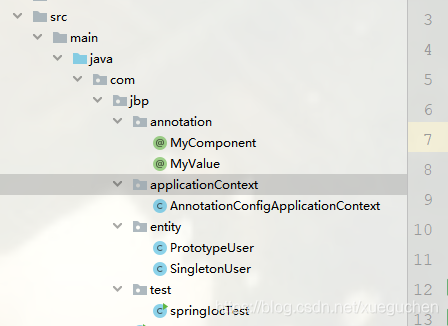Spring之IOC小结(二)基于注解手写IOC
目标:基于注解方式怎样实现动态地创建对象
Demo目录结构:

第一步,创建注解
@Target 属性用于注明此注解用在什么位置 , ElementType.TYPE表示可用在类、接口、枚举上等
@Retention 属性表示所定义的注解何时有效, RetentionPolicy.RUNTIME表示在运行时有效
@interface 表示注解类型
MyComponent:
package com.jbp.annotation;
import java.lang.annotation.RetentionPolicy;
import java.lang.annotation.ElementType;
import java.lang.annotation.Retention;
import java.lang.annotation.Target;
/**
* @Author JiangBeiPing
* @Date 2020/1/7 11:49
* @Version 1.0
**/
//@Target 属性用于注明此注解用在什么位置 , ElementType.TYPE表示可用在类、接口、枚举上等
//@Retention 属性表示所定义的注解何时有效, RetentionPolicy.RUNTIME表示在运行时有效
//@interface 表示注解类型
@Target(ElementType.TYPE)
@Retention(RetentionPolicy.RUNTIME)
public @interface MyComponent {
public String scope();//为此注解定义scope属性
}
MyValue:
package com.jbp.annotation;
import java.lang.annotation.ElementType;
import java.lang.annotation.Retention;
import java.lang.annotation.RetentionPolicy;
import java.lang.annotation.Target;
/**
* @Author JiangBeiPing
* @Date 2020/1/7 11:55
* @Version 1.0
**/
@Target(ElementType.FIELD)
@Retention(RetentionPolicy.RUNTIME)
public @interface MyValue {
public String value();//定义value属性
}
第二步,创建entity对象类型,用于在运行时创建实例对象
PrototypeUser:
package com.jbp.entity;
import com.jbp.annotation.MyComponent;
import com.jbp.annotation.MyValue;
/**
* @Author JiangBeiPing
* @Date 2020/1/7 12:02
* @Version 1.0
**/
@MyComponent(scope="prototype")
public class PrototypeUser {
@MyValue("008")
private Integer id;
@MyValue("xgc")
private String name;
@MyValue("xgc")
private String password;
public PrototypeUser() {
System.out.println("无参构造方法执行");
}
public Integer getId() {
return id;
}
public void setId(Integer id) {
this.id = id;
}
public String getName() {
return name;
}
public void setName(String name) {
this.name = name;
}
public String getPassword() {
return password;
}
public void setPassword(String password) {
this.password = password;
}
@Override
public String toString() {
return "PrototypeUser{" +
"id=" + id +
", name='" + name + '\'' +
", password='" + password + '\'' +
'}';
}
}
SingletonUser:
package com.jbp.entity;
import com.jbp.annotation.MyComponent;
import com.jbp.annotation.MyValue;
/**
* @Author JiangBeiPing
* @Date 2020/1/7 11:57
* @Version 1.0
**/
@MyComponent(scope = "singleton")
public class SingletonUser {
@MyValue("007")
private Integer id;
@MyValue("jbp")
private String name;
@MyValue("jbp")
private String password;
public SingletonUser() {
System.out.println("无参构造方法执行");
}
public Integer getId() {
return id;
}
public void setId(Integer id) {
this.id = id;
}
public String getName() {
return name;
}
public void setName(String name) {
this.name = name;
}
public String getPassword() {
return password;
}
public void setPassword(String password) {
this.password = password;
}
@Override
public String toString() {
return "SingletonUser{" +
"id=" + id +
", name='" + name + '\'' +
", password='" + password + '\'' +
'}';
}
}
第三步,创建AnnotationConfigApplicationContext工厂类
package com.jbp.applicationContext;
import com.jbp.annotation.MyComponent;
import com.jbp.annotation.MyValue;
import java.io.File;
import java.io.FileFilter;
import java.lang.reflect.Field;
import java.lang.reflect.InvocationTargetException;
import java.lang.reflect.Method;
import java.net.URL;
import java.util.Map;
import java.util.concurrent.ConcurrentHashMap;
/**
* @Author JiangBeiPing
* @Date 2020/1/7 12:07
* @Version 1.0
**/
public class AnnotationConfigApplicationContext {
//beanDefinitionFacotry: 容器用于存储类定义对象
private Map<String, Class<?>> beanDefinationFacotry=new ConcurrentHashMap<>();
//singletonbeanFactory: 容器用于存储单例对象
private Map<String,Object> singletonbeanFactory=new ConcurrentHashMap<>();
//有参构造方法,参数类型为指定要扫描加载的包名
public AnnotationConfigApplicationContext(String packageName) {
scanPkg(packageName);//扫描指定的包路径
}
/**
* 扫描指定包,找到包中的类文件
* 对于标准(类上有定义注解的)类文件反射加载创建类定义对象并放入容器中
*/
private void scanPkg(final String pkg){
//替换包名中的".",将包结构转换为目录结构
String pkgDir=pkg.replaceAll("\\.", "/");
//获取目录结构在类路径中的位置(其中url中封装了具体资源的路径)
URL url=getClass().getClassLoader().getResource(pkgDir);
//基于这个路径资源(url),构建一个文件对象
File file=new File(url.getFile());
//获取此目录中指定标准(以".class"结尾)的文件
File[] fs=file.listFiles(new FileFilter() {
@Override
public boolean accept(File file) {
//获取文件名
String fName=file.getName();
//判断该文件是否为目录,如为目录,递归进一步扫描其内部所有文件
if(file.isDirectory()){
scanPkg(pkg+"."+fName);
}else{
//判定文件的后缀是否为.class
if(fName.endsWith(".class")){
return true;
}
}
return false;
}
});
//遍历所有符合标准的File文件
for(File f:fs){
//获取文件名
String fName=f.getName();
//获取去除.class之后的文件名
fName=fName.substring(0,fName.lastIndexOf("."));
//将名字(类名,通常为大写开头)的第一个字母转换小写(用它作为key存储工厂中)
String key=String.valueOf(fName.charAt(0)).toLowerCase()+fName.substring(1);
//构建一个类全名(包名.类名)
String pkgCls=pkg+"."+fName;
try{
//通过反射构建类对象
Class<?> c=Class.forName(pkgCls);
//判定这个类上是否有MyComponent注解
if(c.isAnnotationPresent(MyComponent.class)){
//将类对象存储到map容器中
beanDefinationFacotry.put(key, c);
}
}catch(Exception e){
throw new RuntimeException(e);
}
}
}
/**
*根据传入的bean的id值获取容器中的对象,类型为Object
*/
public Object getBean(String beanId){
//根据传入beanId获取类对象
Class<?> cls = beanDefinationFacotry.get(beanId);
//根据类对象获取其定义的注解
MyComponent annotation = cls.getAnnotation(MyComponent.class);
//获取注解的scope属性值
String scope = annotation.scope();
try {
//如果scope等于singleton,创建单例对象
if ("singleton".equals(scope)){
//判断容器中是否已有该对象的实例,如果没有,创建一个实例对象放到容器中
if (singletonbeanFactory.get(beanId) == null){
Object instance = cls.newInstance();
setFieldValues(cls,instance);
singletonbeanFactory.put(beanId,instance);
}
//根据beanId获取对象并返回
return singletonbeanFactory.get(beanId);
}
//如果scope等于prototype,则创建并返回多例对象
if ("prototype".equals(scope)){
Object instance = cls.newInstance();
setFieldValues(cls,instance);
return instance;
}
//目前仅支持单例和多例两种创建对象的方式
}catch (InstantiationException e){
// e.printStackTrace();
}catch (IllegalAccessException e){
// e.printStackTrace();
}
//如果遭遇异常,返回null
return null;
}
/**
* 此为重载方法,根据传入的class对象在内部进行强转
* @param beanId
* @param c
* @param <T>
* @return 返回传入的class对象的类型
*/
public <T>T getBean(String beanId,Class<T> c){
return (T)getBean(beanId);
}
/**
* 此方法用于为对象的属性赋值
* 内部是通过获取成员属性上注解的值,在转换为类型之后,通过反射为对象赋值
* @param cls 类定义对象
* @param obj 要为其赋值的实例对象
*/
public void setFieldValues(Class<?> cls,Object obj){
//获取类中所有的成员属性
Field[] fields = cls.getDeclaredFields();
//遍历所有属性
for (Field field : fields) {
//如果此属性有MyValue注解修饰,对其进行操作
if (field.isAnnotationPresent(MyValue.class)){
//获取属性名
String fieldName = field.getName();
//获取注解中的值
String value = field.getAnnotation(MyValue.class).value();
//获取属性所定义的类型
String type = field.getType().getName();
//将属性名改为以大写字母开头,如:id改为ID,name改为Name
fieldName = String.valueOf(fieldName.charAt(0)).toUpperCase() + fieldName.substring(1);
//set方法名称,如:setId,setName...
String setterName = "set" + fieldName;
try {
//根据方法名称和参数类型获取对应的set方法对象
Method method = cls.getDeclaredMethod(setterName, field.getType());
//判断属性类型,如类型不一致,则转换类型后调用set方法为属性赋值
if ("java.lang.Integer".equals(type) || "int".equals(type)){
int intValue = Integer.valueOf(value);
method.invoke(obj,value);
}else if ("java.lang.String".equals(type)){
method.invoke(obj, value);
}
//作为测试,仅判断Integer和String类型,其它类型同理
}catch (NoSuchMethodException | SecurityException e){
// e.printStackTrace();
}catch (IllegalAccessException e){
// e.printStackTrace();
}catch (IllegalArgumentException e){
// e.printStackTrace();
}catch (InvocationTargetException e){
// e.printStackTrace();
}
}
}
}
/**
* 销毁方法,用于释放资源
*/
public void close(){
beanDefinationFacotry.clear();
beanDefinationFacotry=null;
singletonbeanFactory.clear();
singletonbeanFactory=null;
}
}
第三步,测试
package com.jbp.test;
import com.jbp.applicationContext.AnnotationConfigApplicationContext;
import com.jbp.entity.PrototypeUser;
import com.jbp.entity.SingletonUser;
/**
* @Author JiangBeiPing
* @Date 2020/1/7 15:56
* @Version 1.0
**/
public class springIocTest {
public static void main(String[] args) {
//创建AnnotationConfigApplicationContext对象
AnnotationConfigApplicationContext ctx = new AnnotationConfigApplicationContext("com.jbp.entity");
//仅使用key作为参数获取对象,需要强转
SingletonUser singletonUser1=(SingletonUser) ctx.getBean("singletonUser");
System.out.println("单例User对象:"+singletonUser1);
//使用key和类对象作为参数获取对象,无需强转
SingletonUser singletonUser2=ctx.getBean("singletonUser",SingletonUser.class);
System.out.println("单例User对象:"+singletonUser2);
//仅使用key作为参数获取对象,需要强转
PrototypeUser prototypeUser1=(PrototypeUser) ctx.getBean("prototypeUser");
System.out.println("多例User对象:"+prototypeUser1);
//使用key和类对象作为参数获取对象,无需强转
PrototypeUser prototypeUser2=ctx.getBean("prototypeUser",PrototypeUser.class);
System.out.println("多例User对象:"+prototypeUser2);
//关闭资源
ctx.close();
}
}
测试结果:

